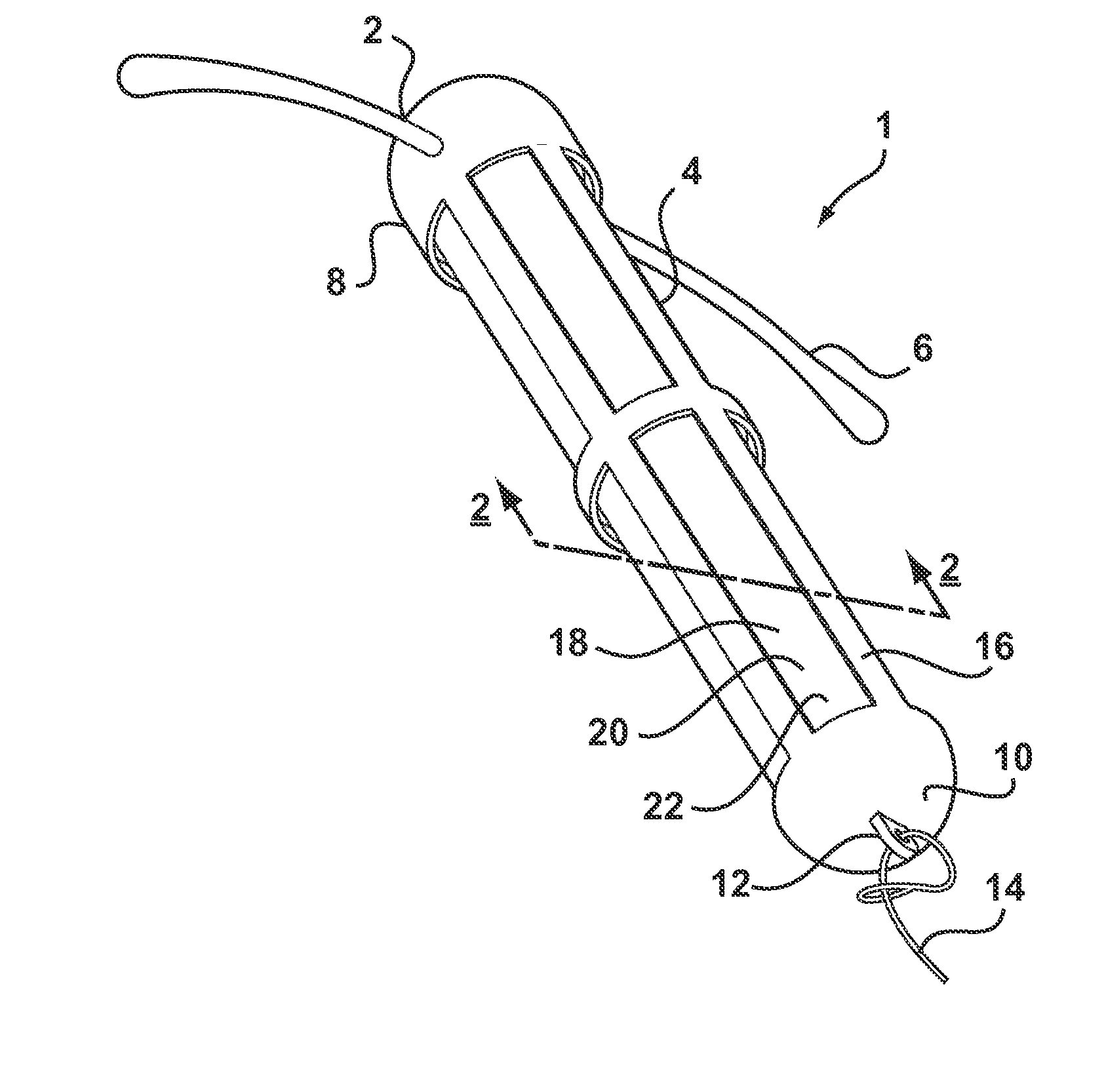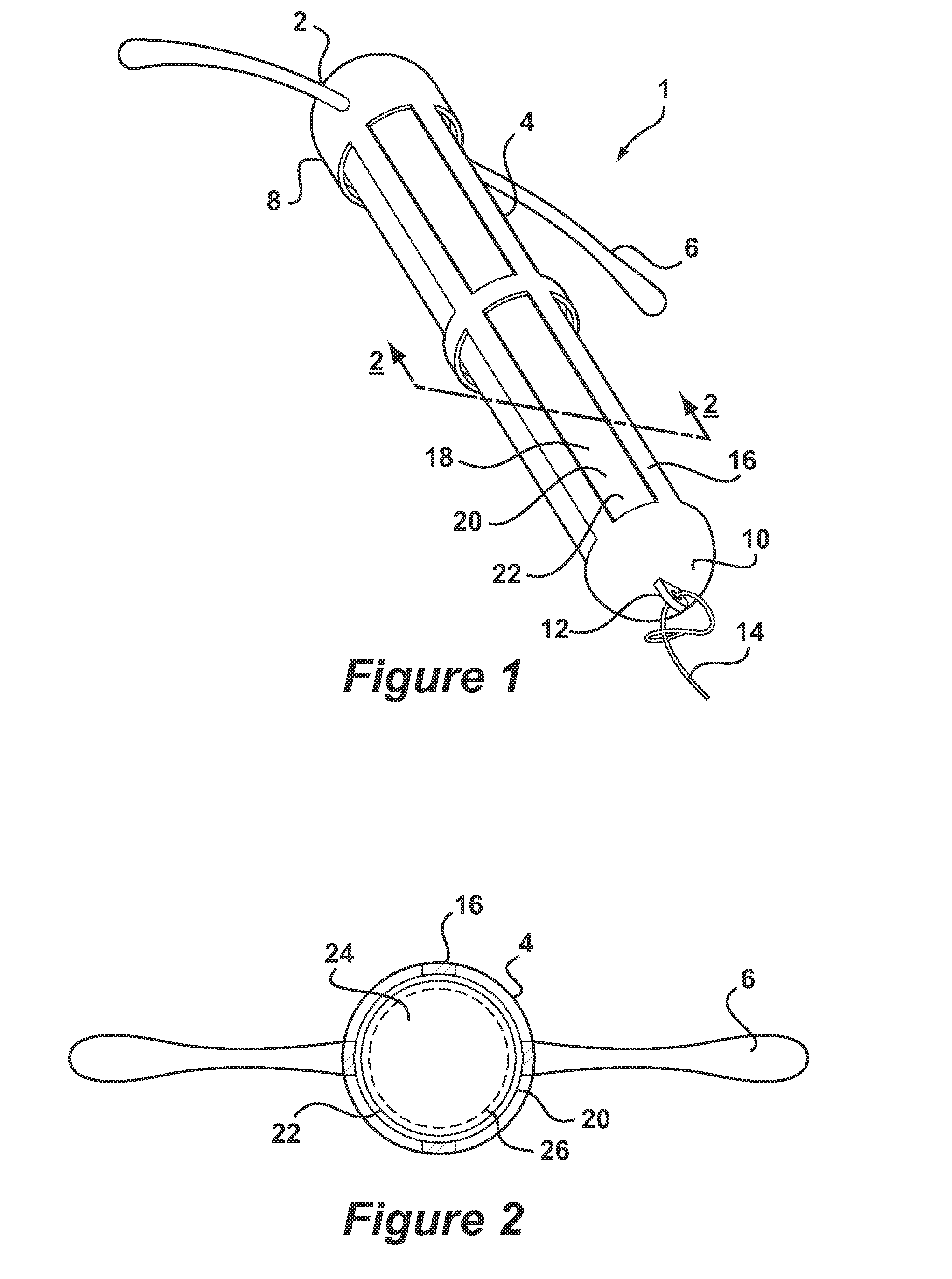Intrauterine deposit
a technology of intrauterine and deposit, which is applied in the field of intrauterine systems, can solve the problems of increasing bleeding of copper coil type iuds, complicated moulding procedures, and difficulty in ensuring correct dosage of agents,
- Summary
- Abstract
- Description
- Claims
- Application Information
AI Technical Summary
Benefits of technology
Problems solved by technology
Method used
Image
Examples
first embodiment
[0038]Referring to FIG. 1, there is shown an intrauterine system 1 according to the invention. The IUD 1 has a body 2 comprising a stem 4 with a pair of laterally extending arms 6 connected at its upper end 8. At a lower end 10 of the stem 4, there is provided an eye 12 to which is connected a nylon thread 14. The stem 4 is formed by a frame 16 having openings 18 to an interior space 20. Within the interior space 20 is located a rod shaped deposit 22.
[0039]FIG. 2 shows a cross-sectional view through the IUD 1 taken along line 2-2. FIG. 2 shows more clearly the frame 16 of the stem 4 and the deposit 22 received within the interior space 20. FIG. 2 also shows the deposit 22 to comprise a core 24 and an outer membrane 26. Core 24 is formed of a matrix consisting of EVA copolymer with a vinyl acetate percentage of 28%, to which a quantity of biologically active compound has been added. In the present embodiment, the core 24 is loaded with etonogestrel at 54 wt % with respect to other co...
second embodiment
[0041]FIG. 3 depicts an IUD 100 according to the invention in which like reference numerals preceded by a 1 will be used to represent the same features as in the system of FIGS. 1 and 2. According to FIG. 3, IUD 100 comprises a body 102 having a stem 104. The stem 104 is formed by a helical coil 116 having openings 118 and an interior space 120. The coil 116 is preferably made of metal but could also be a moulded plastic component. Arms 106 are integrally formed with an upper end 108 of the stem 104 in which the coil 116 is embedded by a moulding procedure. A lower end 110 of the stem 104 is also formed as a moulding and provided with an eye 112 to which is connected thread 114. A deposit 122 is retained in the interior space 120. The deposit 122 may be generally identical to that of FIGS. 1 and 2. Insertion of the deposit 122 into interior space 120 takes place by deformation of the coil 116. Although the thread 114 is depicted as attaching to the lower end 110, it may also be desi...
third embodiment
[0042]FIGS. 4 and 5 depict an IUD 200 according to the invention in which like reference numerals preceded by a 2 will be used to represent the same features as in the system of FIGS. 1 and 2. According to FIG. 4, the IUD 200 comprises a body 202 having a stem 204 formed in two frame halves 205, 205′ having snap elements 209. Eyes 212, 212′ are formed at lower ends 210, 210′ of frame halves 205, 205′. An upper end 208 of the stem 204 carries a pair of arms 206.
[0043]The body 202 is formed in an injection moulding procedure having living hinges 207, 207′ between the frame halves 205, 205′ and the upper end 208. After insertion of a deposit 222, the frame halves 205, 205′ are snapped together to form the stem 204 as shown in FIG. 5. The deposit 222 is now retained in interior space 220. Deposit 222 may be generally identical to that of FIGS. 1 and 2. Thread 214 is then passed through eyes 212, 212′ further restraining the frame halves 205, 205′ from opening.
PUM
| Property | Measurement | Unit |
|---|---|---|
| diameter | aaaaa | aaaaa |
| outer diameter | aaaaa | aaaaa |
| diameter | aaaaa | aaaaa |
Abstract
Description
Claims
Application Information
 Login to View More
Login to View More - R&D
- Intellectual Property
- Life Sciences
- Materials
- Tech Scout
- Unparalleled Data Quality
- Higher Quality Content
- 60% Fewer Hallucinations
Browse by: Latest US Patents, China's latest patents, Technical Efficacy Thesaurus, Application Domain, Technology Topic, Popular Technical Reports.
© 2025 PatSnap. All rights reserved.Legal|Privacy policy|Modern Slavery Act Transparency Statement|Sitemap|About US| Contact US: help@patsnap.com



